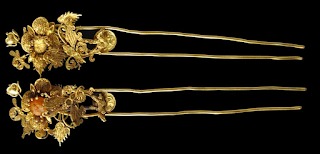My First Past Life Regression: A Journey Back to Qing Dynasty China
Do you believe in past life?
Before I ever started doing tarot readings, something unexpected happened that marked the beginning of my spiritual journey. It all started with a casual online chat with a friend I barely knew. We connected over shared interests, and one day, she asked me if I’d ever done a past life regression. At the time, I had no idea what that even was. I told her so, and she sent me a YouTube link. That link would change everything.
The link was a guided meditation for past life regression in Vietnamese—my mother tongue. Intrigued, I decided to give it a try. I was nervous and skeptical. I’d never done meditation before, and the idea of exploring a past life felt both thrilling and a little far-fetched. But the curiosity was too strong to ignore, especially since I’ve always had vivid dreams of places I’ve never been to and experiences I couldn’t explain.
I chose a time when I felt comfortable—not tired, not sleepy—and lay down to listen. As I followed the instructions, I stayed awake the whole time, fully immersed in the process. What I saw and felt during that session has stayed with me ever since.
The first images that came to me were of the Qing Dynasty and the Forbidden City. At first, I dismissed it, thinking, Maybe I’ve just watched too many Chinese dramas. But as the vision unfolded, it felt too detailed and too personal to be imagination. I saw myself as a young girl, maybe 12 or 13 years old. My name might have been Jin, or something similar. I had a round, pale face, small feet—though not small enough, which made me feel self-conscious—and I seemed to belong to a royal family living near the Forbidden City.
The room I saw wasn’t overly luxurious but still carried an air of privilege. I was searching for something—an instrument—but I couldn’t find it. Nearby, someone was carving wood, and I felt they might have been making the instrument I was looking for. Later, the meditation prompted me to see who I shared meals with. The dining table was full of women and children, and one of the older women looked strikingly like my nanny from this life.

The meditation guided me further, and I witnessed the end of that life. I was running, pursued by soldiers who didn’t belong to the Qing Dynasty. They wore uniforms that matched the Republican era of China, which overthrew the Qing Dynasty in 1912. The chase ended at a cliff. I don’t remember jumping or being harmed, but I know I didn’t survive. I was just a child, and my life was over before it had truly begun.
When I woke up from the regression, I was crying. The sadness of that short, unfulfilled life weighed on me. I hadn’t even had the chance to play the instrument I was so desperate to find.
Years later, I visited China and stood before the Forbidden City. Inside, I felt like a tourist, but outside, at places like Xiximen Square, I felt an overwhelming connection. I even learned from the tour guide that Manchu royals often lived near the Forbidden City if they weren’t inside it—something I had seen in my regression but hadn’t known before.
One detail that struck me deeply was the mention of foot binding. The tour guide explained how Empress Dowager Cixi tried to ban the practice in 1902, though it wasn’t fully stopped until later. In my regression, I’d seen myself with feet that were small but not bound, which aligned with the transitional period of that time.
The most chilling moment came when the guide pointed out a sword statue in front of Mao Zedong’s painting. It was placed there, according to Feng Shui, to sever the “dragon lineage” of the Manchu royals. Hearing this gave me goosebumps. It felt personal, as if I was somehow tied to that history.
Reflecting on my past life, I see how it connects to my astrology chart. My North Node is in Scorpio in the 8th House, while my South Node is in Taurus in the 2nd House. This suggests that my past life was focused on wealth and stability, which aligns perfectly with what I saw. Living in a siheyuan as part of royalty, I was surrounded by comfort and tradition, but my life was confined to maintaining that stability. I didn’t have the freedom to explore or grow. Now, in this life, my chart encourages me to embrace transformation, let go of material attachments, and pursue deeper, more meaningful experiences.
I’m incredibly thankful for this lifetime. I’ve had the chance to grow up, pursue my passions, and do things I didn’t get to do as a little girl in the Qing Dynasty. I learned to play the guzheng, a traditional Chinese instrument, and became advanced in just three years. The instrument felt strangely familiar in my hands, as if I’d connected to it before. I’ve also pursued ballet, driven by a desire to experience having small, delicate feet—a connection to the ideals of beauty that lingered from that past life.
Looking back, I see how my past life shaped who I am today. It gave me a deep appreciation for tradition and stability, but it also motivated me to live fully and embrace the opportunities I have now. I’m no longer confined to a siheyuan or tied to expectations of wealth and status. Instead, I’m free to create, grow, and explore—something I’ll never take for granted.


Comments
Post a Comment